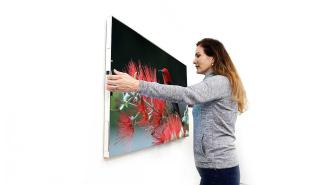Home entertainment startup Displace has unveiled a completely wireless TV that vacuum seals to walls — no mounting hardware required.
The challenge: While there are a few battery-powered televisions on the market, they’re designed for portability and generally max out at about 14 inches. If you want a TV big enough to see from across your living room, you’re going to need to plug it into an outlet.
That means figuring out something to do with the unsightly power cord — you might opt to drill a couple of holes in your wall so you can run the cable behind it, or going the easier but messier-looking route of buying and installing some other type of cable management system.
Vacuum technology lets the wireless TV stick to flat surfaces without mounting hardware.
What’s new? Displace recently unveiled a 55-inch wireless TV designed for home use at CES, the massive annual tech event where startups and industry giants alike debut and demo their latest consumer products.
The DisplaceTV’s four rechargeable batteries collectively provide enough juice for you to watch six hours of TV per day for a month, and because it only needs one battery to operate, you can charge the others while you watch.
The totally wireless TV doesn’t have any ports, but it does come with a base unit you can plug your cable box, gaming system, or other devices into — anything you want to watch is then streamed wirelessly from that unit to the TV.
You can put four of the wireless TVs together on a wall to create one 110-inch screen.
Suck up: The lack of a power cord is just one of the DiplaceTV’s unique features.
The back of the wireless TV is equipped with a vacuum technology that allows it to stick to flat surfaces without mounting hardware. To unmount the 20-pound TV, just press and hold a button.
But the vacuum technology does require power, so if you let your DisplaceTV’s batteries all die, it could come crashing down. To avoid that scenario, the TV is designed to issue several on-screen warnings when battery power is low.
The DisplaceTV is also modular, meaning you can put four of the TVs together on a wall to create one 110-inch screen. It also has a special camera that allows you to control the TV with gestures, but you can opt to use its voice or touch interfaces, or a remote app.
Order up: Displace is currently accepting refundable deposits for its wireless TV, which comes with one base unit. The total cost of that system is $2,999, but you can also purchase a package consisting of 2 or 4 TVs and one base unit for $5,399 and $8,999, respectively.
Displace plans to ship the TVs in December 2023 and is initially taking reservations for only 100 units — at the time of writing, its website claims that only 8 are unclaimed.
Looking ahead: While many of the products featured at CES are never heard from again, others turn out to be absolute game changers — the CD player, DVD player, and Nintendo Entertainment System all debuted at the showcase.
It’s too soon to say whether Displace’s new wireless TV will fall into the first category, second, or somewhere in between, but if it catches on, we might one day look at it as a turning point in TV tech — the same way the first flatscreens led to the death of tube TVs, this one could kill the power cord.
We’d love to hear from you! If you have a comment about this article or if you have a tip for a future Freethink story, please email us at [email protected].






